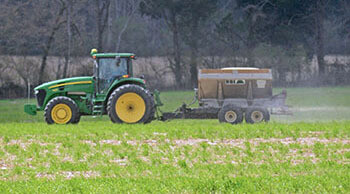Prepare Your Spreader Now for the Spring Rush
Jan 04, 2021

With spring fast approaching and planting season just around the corner, now is the time to ensure your fertilizer spreader is ready for the task. Spreaders that have been idle over the winter months need a thorough service and inspection to safeguard against in-season downtime. Follow these seven steps to get ahead of the game before it starts.
Performing the steps on this checklist, as with all preventive maintenance, can greatly reduce the cost and extend the life of your spreader.
- Check for any broken welds, including hopper, tongue, and sub-frame.
- Inspect and replace broken or worn spinner fins.
- Inspect the conveyor chain for damage and adjust to the proper specs.
- Inspect and grease all bearings including wheel hubs.
- Check the gearbox fluid levels (if equipped) .
- Verify that the gate opening and flow divider are set at the appropriate position for the product being spread.
- Run a spread test over pans to verify a uniform pattern.
Performing the steps on this checklist, as with all preventive maintenance, can greatly reduce the cost and extend the life of your spreader.